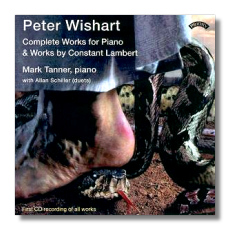
The Internet's Premier Classical Music Source
Related Links
- Latest Reviews
- More Reviews
-
By Composer
-
Collections
DVD & Blu-ray
Books
Concert Reviews
Articles/Interviews
Software
Audio
Search Amazon
Recommended Links
Site News
 CD Review
CD Review
Peter Wishart

The Complete Piano Works
- Peter Wishart:
- Opheis Kai Klimakes, Op. 35 (Snakes & Ladders), 1959
- Partita in F Sharp Major, Op. 10, 1950
- Sonata for Piano Duet in B Flat Major, Op. 5, 1949 *
- Constant Lambert:
- Suite in three (continuous) movements, 1925
- Prize Fight, arr. for piano duet by the composer, 1924 *
Mark Tanner, piano
* Allan Schiller, piano
Priory PRCD881 73:43
Critical summary: brilliant playing of obscure works
Peter Wishart (1921-1984), of Scottish descent and English upbringing, studied in Paris with Nadia Boulanger, as well as at Birmingham University. He later became a professor at Birmingham, Reading and elsewhere. His scholarly work included a three volume edition of Purcell's songs, done with his third wife, who later established a festival in Wishart's name. He wrote five operas, choral music, incidental music for plays, choral music, songs, two symphonies, quartets, and concertos for violin and for piano. His surviving music for piano alone is on this disc.
The strange title of Snakes and Ladders is taken from a children's board game involving, I understand, more chance than skill. As I am personally unacquainted with the game, I am not in a position to discuss it in terms of the music. Mark Tanner in his extensive notes for this release (about 18 pages, all in English) suggests a debt to Hindemith's Ludus Tonalis, as well as to Shostakovich's Preludes and Fugues. The piece has never been published; played in by its dedicatee Alexander Kelly in Scotland and in Wigmore Hall in 1960, it was next played, again in Wigmore Hall, by Mark Tanner, nearly a half-century later, and recorded in Bristol. To be sure, it is complex and challenging to play; its frequent passages with intervals of 9ths and 10ths require a pianist with large hands capable of strenuous playing. It is in six movements, the first and last unmarked as to tempo. Tanner takes the opening at a moderate pace, his playing firm and emphatic, then quiet. The rather Bach-like final section) is played fast rather than slow. In the middle movements Tanner plays with a varied attack, from loud and emphatic to a light touch in fast passages. A presto movement comes at least close to jazzy and the adagio is mostly gentle. So is the piece playful? I would say yes, at least at times. I find none of it jarring. Tanner says of this work that "one is never too far from a charming lyrical passage, quirky rhythmic cameo or enticing concoction of harmonies to tease with one's sense of tonal centre." Of Wishart's music in general Tanner speaks of "tightly argued structure and consistently innovative ideas."
The relatively short Partita comprises a gentle Prelude, a vigorous Burlesca, a song-like Aria and a final Capriccio. The Sonata begins with a vigorous Prelude and continues with seven brief variations, the character of which vary from gentle to impetuous, crisp and percussive.
In contrast to his provocative and, to me off-putting book, Music Ho!, I find Constant Lambert's piano music appealing. He studied with Vaughan Williams at the Royal College of Music and was influenced by Diaghilev'e Ballet Russe, for which he wrote a ballet, Roméo and Juliet, in 1928. This Suite was performed by the composer at the RCM when he was 19 but for unspecified legal reasons the work was not performed again for many years. The three movements are based on a single theme. Clearly influenced by Debussy, it even uses whole tones. It also has echoes of Liszt and even Streavinsky whom Lambert was so down on in his famous book. The Suite begins with limpid and sonorous sounds but turns to staccato notes and jazzy, catchy rhythms before it ends quietly.
Prize Fight, Satie-like in character, was composed for a percussion-dominated orchestra and re-written for piano duet is, as one would expect, a hard-hitting work, punctuated on occasion by a bell (not a tubular one.) There are some polyrhythms (e.g. 12/8 against 4/4) and "When Johnny Comes Marching Home" is quoted.
The second pianist, Allan Schiller, played with the Hallé Orchestra under Barbirolli at the age of ten, and was the first British pianist to win a scholarship to the Moscow Conservatoire. Especially known for his Mozart performances, his playing technique emphasizes the "vocal way," in which "instead of hitting the keyboard he coaxes sound from it in such a way as to make one forget the piano is a percussive instrument whose sound is forever dying. Mark Tanner, in contrast, at least to my ears, uses very different techniques. What most strikes me about Tanner's playing is the enormous range of sounds he brings forth even within movements, as I have tried to describe.
Copyright © 2007, R. James Tobin




















